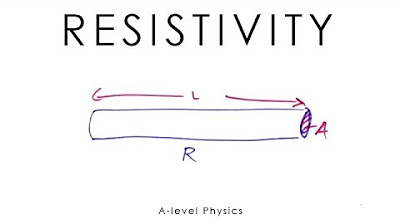Resistivity | Specific Resistance | Easier Explanation
TLDRThe video script discusses the concept of electrical resistivity, its dependence on factors such as conductor dimensions, material properties, and temperature. It explains how resistivity varies with the length and cross-sectional area of the conductor, and the importance of material type in determining resistivity. The script also differentiates between resistivity and specific resistivity, providing a formula for calculating specific resistivity and emphasizing the inverse relationship between current and resistance.
Takeaways
- 😀 The video discusses the concept of 'Date Ij Registriti', which seems to be a play on words for 'Electrical Resistivity'.
- 🔍 It mentions that resistivity does not depend on the speed of the conductor but is influenced by other factors such as temperature and material properties.
- 🌡️ The script talks about the effect of temperature on resistivity, indicating that changing the temperature can alter the resistivity of a conductor.
- 🔌 The video explains that resistivity is directly proportional to the length of the conductor and inversely proportional to its cross-sectional area.
- 📏 It emphasizes the importance of the dimensions of the conductor, stating that longer conductors have higher resistivity due to more atoms per unit length.
- ⚙️ The material of the conductor is highlighted as a significant factor in determining resistivity, with different materials like copper, aluminum, and tungsten having different resistive properties.
- 🔄 The concept of current flow is introduced, explaining how the number of free electrons (or 'Adams' in the script) affects the resistance and, consequently, the electrical resistivity.
- 📉 The video suggests that increasing the temperature generally increases resistivity, which can be inferred from the mention of 'conductor crash' and 'temperature of contact'.
- 📚 It introduces the formula for calculating resistivity and emphasizes the need to understand the units involved in the calculation.
- 🔑 The script distinguishes between 'resistivity' which depends on the material and its temperature, and 'specific resistivity', which is a property inherent to the material itself.
- 👍 The importance of understanding the relationship between resistivity, the length and area of the conductor, and the material's nature is stressed for anyone studying or working with electrical systems.
Q & A
What is the main topic of the video?
-The main topic of the video is 'Date is Resistivity', which discusses the factors affecting the electrical resistivity of materials.
What are the three factors mentioned in the video that affect the electrical resistivity of a conductor?
-The three factors mentioned are the dimensions of the conductor, the temperature, and the nature of the material it is made of.
How does the length of a conductor affect its electrical resistivity?
-The electrical resistivity is directly proportional to the length of the conductor. The longer the conductor, the higher the resistivity, and vice versa.
What is the relationship between the cross-sectional area of a conductor and its electrical resistivity?
-The electrical resistivity is inversely proportional to the cross-sectional area of the conductor. A larger cross-sectional area results in lower resistivity.
How does the temperature affect the electrical resistivity of a conductor?
-The temperature can change the resistivity of a conductor by altering its temperature. The exact effect depends on the material, but generally, resistivity increases with temperature for most conductors.
What is specific resistivity and how is it different from resistivity?
-Specific resistivity is a property of the material that depends on the material's nature and temperature, but not on its dimensions. It is different from resistivity, which also depends on the conductor's length and cross-sectional area.
What is the formula for calculating specific resistivity?
-The formula for specific resistivity is Resistivity divided by the length of the conductor and multiplied by the cross-sectional area of the conductor.
How does the nature of the material used in a conductor influence its electrical resistivity?
-Different materials have different inherent resistivities due to the structure and type of atoms or ions they contain. This nature directly influences the conductor's resistivity.
What does the video suggest about the importance of understanding resistivity in practical applications?
-The video suggests that understanding resistivity is crucial for applications involving electrical conductivity, as it helps in selecting appropriate materials and designing efficient electrical systems.
Why is it important to distinguish between resistivity and specific resistivity when analyzing electrical properties?
-It is important because resistivity is a property that depends on the physical dimensions of the conductor, while specific resistivity is an intrinsic property of the material itself, independent of its size or shape.
How can one calculate the resistance of a conductor using the information provided in the video?
-One can calculate the resistance of a conductor by using the formula that involves resistivity, the length of the conductor, and its cross-sectional area. The resistance is equal to the resistivity multiplied by the length and divided by the cross-sectional area.
Outlines
🔬 Understanding Electrical Resistivity and Its Factors
The first paragraph introduces the concept of electrical resistivity, discussing its dependence on various factors such as conductor dimensions, temperature, and the material's nature. It explains how resistivity is not directly written on the board but is introduced through a step-by-step approach. The paragraph also touches on the importance of conductor length, cross-sectional area, and temperature in determining resistivity, emphasizing the relationship between these factors and the electrical resistance of a conductor.
🔍 The Relationship Between Conductor Area and Electric Current
This paragraph delves into the relationship between the cross-sectional area of a conductor and its ability to carry electric current. It explains that a larger area allows for more current to flow, and vice versa. The discussion also covers the inverse proportionality between resistance and the cross-sectional area, highlighting how reducing the area increases resistance and affects the flow of current. The paragraph further explores the concept of specific resistance, emphasizing its calculation and the significance of the conductor's material and temperature.
📚 Calculating Specific Resistivity and Its Units
The third paragraph focuses on the calculation of specific resistivity, providing a formula that involves the resistance value, length, and area of the conductor. It discusses the units involved in the calculation, such as ohm-meters, and how they relate to the physical properties of the material. The paragraph also clarifies the difference between resistivity and resistance, noting that resistivity is a material-specific property, while resistance depends on the conductor's dimensions and material.
📢 Conclusion and Encouragement to Subscribe
The final paragraph serves as a conclusion, summarizing the key points discussed in the video script about electrical resistivity and its calculation. It encourages viewers to subscribe to the channel for more informative content and reminds them to like and share the video. The paragraph ends with a note of thanks for watching, reinforcing the value of the information provided and the importance of understanding electrical resistivity.
Mindmap
Keywords
💡Resistivity
💡Conductor
💡Temperature
💡Cross-sectional Area
💡Length
💡Electrical Resistance
💡Specific Resistivity
💡Material
💡Temperature Coefficient
💡Ohm's Law
💡Conductor's Nature
Highlights
Today's topic is resistivity and its impact on electrical resistance.
Electrical resistance depends on three main factors: length, temperature, and material of the conductor.
Increasing the temperature of a conductor changes its electrical resistance.
The material of the conductor, such as copper, aluminum, or tungsten, affects its electrical resistance.
Resistance is directly proportional to the length of the conductor.
Resistance is inversely proportional to the cross-sectional area of the conductor.
The relationship between current and resistance: higher current means lower resistance and vice versa.
Combining the relationships of length and area to calculate resistance.
The formula for calculating resistance involves the length and cross-sectional area of the conductor.
Resistivity is a material property that does not depend on the dimensions of the conductor.
The unit of resistivity is ohm-meter.
Resistivity is crucial for understanding the intrinsic properties of materials.
Resistance varies with changes in temperature and material nature.
Resistivity remains constant for a given material and temperature.
Understanding the difference between resistance and resistivity is essential for electrical engineering.
Transcripts
5.0 / 5 (0 votes)
Thanks for rating:





